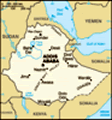Ethiopian Economy, Ethiopia Economy
Advertisement
Economy - overview: Ethiopia's poverty-stricken economy is based on agriculture, accounting for half of GDP, 60% of exports, and 80% of total employment. The agricultural sector suffers from frequent drought and poor cultivation practices. Coffee is critical to the Ethiopian economy with exports of some $156 million in 2002, but historically low prices have seen many farmers switching to qat to supplement income. The war with Eritrea in 1998-2000 and recurrent drought have buffeted the economy, in particular coffee production. In November 2001, Ethiopia qualified for debt relief from the Highly Indebted Poor Countries (HIPC) initiative. Under Ethiopia's land tenure system, the government owns all land and provides long-term leases to the tenants; the system continues to hamper growth in the industrial sector as entrepreneurs are unable to use land as collateral for loans. Drought struck again late in 2002, leading to a 2% decline in GDP in 2003. Normal weather patterns late in 2003 helped agricultural and GDP growth recover in 2004.
GDP: 4.6% (2004)
GDP - real growth rate: 11.6% (2004 est.)
GDP - per capita: Purchasing power parity - $800 (2004 est.)
GDP - composition by sector: Agriculture: 47% industry: 12.4% services: 40.6% (2004 est.)
Population below poverty line: 50% (2004 est.)
Household income or consumption by percentage share: Lowest 10%: 3% highest 10%: 33.7% (1995)
Distribution of family income - Gini index: 40 (1995)
Inflation rate (consumer prices):
Labor force: NA (2001 est.)
Labor force - by occupation: Agriculture and animal husbandry 80%, industry and construction 8%, government and services 12% (1985)
Unemployment rate: NA (2002)
Budget: Revenues: $1.887 billion expenditures: $2.388 billion, including capital expenditures of $788 million (2004 est.)
Industries: Food processing, beverages, textiles, chemicals, metals processing, cement
Industrial production growth rate: 6.7% (2001 est.)
Electricity - production: 2.149 billion kWh (2002)
Electricity - production by source:
Electricity - consumption: 1.998 billion kWh (2002)
Electricity - exports: 0 kWh (2002)
Electricity - imports: 0 kWh (2002)
Oil - production: 0 bbl/day (2001 est.)
Oil - consumption: 23,000 bbl/day (2001 est.)
Oil - exports: NA
Oil - imports: NA
Oil - proved reserves: 214,000 bbl (1 January 2002)
Natural gas - production:
Natural gas - consumption:
Natural gas - exports:
Natural gas - imports:
Natural gas - proved reserves: 12.46 billion cu m (1 January 2002)
Agriculture - products: Cereals, pulses, coffee, oilseed, sugarcane, potatoes, qat; hides, cattle, sheep, goats
Exports: $562.8 million f.o.b. (2004 est.)
Exports - commodities: Coffee, qat, gold, leather products, live animals, oilseeds
Exports - partners: Djibouti 13.3%, Germany 10%, Japan 8.4%, Saudi Arabia 5.6%, US 5.2%, UAE 5%, Italy 4.6% (2004)
Imports: $2.104 billion f.o.b. (2004 est.)
Imports - commodities: Food and live animals, petroleum and petroleum products, chemicals, machinery, motor vehicles, cereals, textiles
Imports - partners: Saudi Arabia 25.3%, US 15.8%, China 6.6% (2004)
Debt - external: $2.9 billion (2001 est.)
Economic aid - recipient: $308 million (FY00/01)
Currency:
Currency code:
Exchange rates: Birr per US dollar - 8.68 (2004), 8.5997 (2003), 8.5678 (2002), 8.4575 (2001), 8.2173 (2000) note: since 24 October 2001 exchange rates are determined on a daily basis via interbank transactions regulated by the Central Bank
Fiscal year: 8 July - 7 July
Advertisement
The information here has been derived from Public Domain Sources such as the CIA World Factbook. No liability can be taken for any inaccuracies.
Tot: 0.051s; Tpl: 0.008s; cc: 4; qc: 6; dbt: 0.011s; 1; m:domysql w:travelblog (10.17.0.13); sld: 1;
; mem: 1.1mb

 Unique among African countries, the ancient Ethiopian monarchy maintained its freedom from colonial rule, with the exception of the 1936-41 Italian occupation during World War II. In 1974 a military junta, the Derg, deposed Emperor Haile SELASSIE (wh...
Unique among African countries, the ancient Ethiopian monarchy maintained its freedom from colonial rule, with the exception of the 1936-41 Italian occupation during World War II. In 1974 a military junta, the Derg, deposed Emperor Haile SELASSIE (wh...
